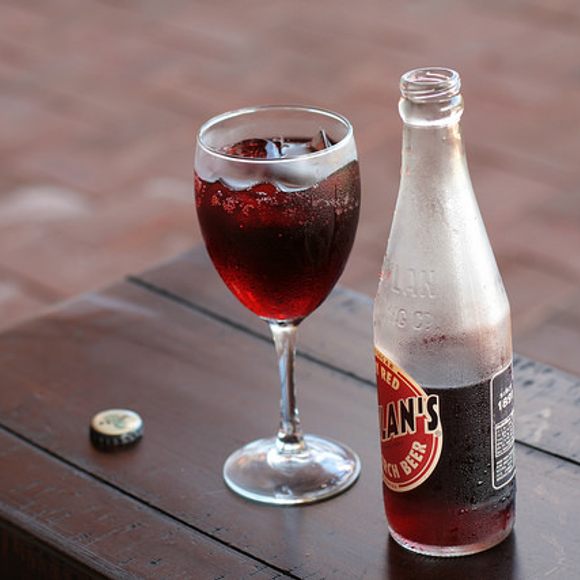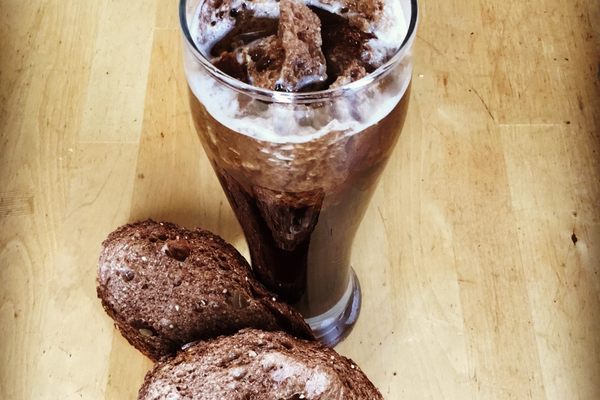Minty-sweet birch beer—a quencher unique to the Northeastern United States—predates Coca-Cola by hundreds of years. And that means it has lived many lives through multiple soda eras.
Early birch beer, made by the English and later by American colonists, was a low-alcohol “small beer” brewed from birch sap, sugar, and yeast. Agriculturalist John Mortimer’s 1707 book The Whole Art of Husbandry notes that birch beer was usually made by poor people. He describes this recipe: “To every Gallon whereof [of sap] add a pound of refined Sugar, and boil it about a quarter, or Half an hour, then set it to cool, and add a very little Yeast to it, and it will ferment.” Many American colonists were poor, and birch beer was an affordable alternative to imported beer and spirits.
But the modern era of soda began, ironically, as a health trend. In the 19th century, mass-produced tonics and tinctures claimed to treat everything from indigestion to cancer. Bubbly mineral water was thought to have curative properties, and early soda fountains, located inside pharmacies, dispensed artificially carbonated drinks sweetened with flavored syrup. These “medicinal” sodas were touted as pick-me-ups that could address exhaustion, high blood pressure, headaches, and upset stomachs. They were often laced with narcotics and alcohol.
However, as temperance movements gained steam in the 1880s and 90s, it became important that these fizzy refreshments not contain booze. Birch beer, along with root beer, ginger ale, and a host of other sweet, herbal beverages, were marketed to the public as healthy, wholesome “family drinks.”
Nonalcoholic birch beer is easily made with the same ingredients as the boozy variety, but must be immediately bottled rather than allowed to sit over several days. The simplest version is a combination of birch extract, a sweetener, and carbonated water. Birch sap is colorless, and the beer can be clear, but brown sugar or coloring is often used to turn it brown or red.
American birch beer is unique due to the particular kind of birch available for tapping. Betula lenta, the sweet birch tree, grows in a territory that begins in Canada and ends in northern Alabama and Georgia. The sweet birch is also called “spice birch” because of its fragrant sap and bark. Sweet birch sap has a distinct minty scent and flavor, which it imparts to birch beer.
Though birch beer remains relatively unknown to Americans outside the Northeast, it’s produced by several much-loved regional brands. New Jersey’s century-old Boylan’s Birch Beer comes in original and a vanilla-flavored, red variety. Connecticut’s Foxon Park White Birch is clear-colored and minty. Pennsylvania Dutch Birch Beer, the nation’s most popular brand, makes both regular and diet versions. Most of these companies have been around since the early 20th century, a testimony to birch beer’s enduring appeal.
Where to Try It
-
Frank Pepe's The Spot
157 Wooster St, New Haven, 06511, USAThis classic New Haven establishment is a fantastic place to enjoy White Birch Beer while enjoying "clam apizza" or other great slices.
Written By
 Anne Ewbank
Anne Ewbank
Edited by
Sources
- www.leaf.tv/articles/how-to-make-homemade-birch-beer/
- books.google.ca/books?id=DOJMAgAAQBAJ&pg=PA162&dq=%22birch+beer%22&hl=en&sa=X&redir_esc=y#v=onepage&q=%22birch%20beer%22&f=false
- archive.org/details/wholearthusband00mortgoog
- www.theguardian.com/lifeandstyle/allotment/2012/mar/21/allotments-gardens
- www.cooksinfo.com/birch-beer
- www.na.fs.fed.us/spfo/pubs/silvics_manual/volume_2/betula/lenta.htm
- modernfarmer.com/2014/12/birch-beer-best-soda-youve-never-tried/















